When do stretch marks appear on the abdomen during pregnancy?
The epidermis contains collagen and elastin fibers, which normally stretch when stretched and then return to their original position. When stretch marks appear on the abdomen during pregnancy, the skin, under the influence of various factors, may not return to normal. Tissues rupture, cells do not have time to regenerate, and stretch marks form.
The main reason for this situation is most often hormonal changes and excessive production of estrogen, which weakens the regeneration of skin cells. Other risk factors include:
- content in the diet of a minimum of vitamins and minerals. The quality of nutrition should be improved through fruits, vegetables and lean fish;
- sudden weight gain when the skin does not have time to stretch;
- lack of physical activity to maintain the tone of the whole body;
- genetic predisposition;
- the presence of bad habits (smoking) leads to weakening of the fibers.
First of all, stretch marks begin in the second trimester, when the fetus begins to grow rapidly and gain weight. The skin tightens too much, which leads to small tears.
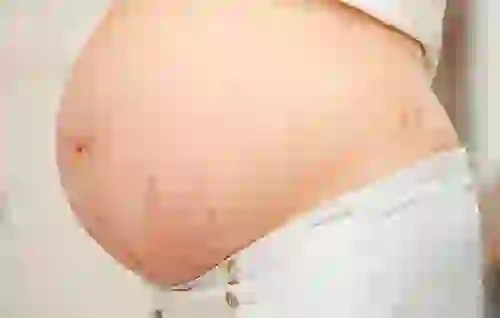
If the stretch marks in the lower abdomen itch slightly, this indicates rapid stretching and the appearance of new stretch marks. They look like red, burgundy, and rarely blue vertical stripes, which fade over time and become less noticeable. Horizontal stretch marks are rare during pregnancy, and they say that the cause is hormonal imbalance.
What to do and how to avoid stretch marks on the stomach during pregnancy
It is possible to avoid stretch marks on the abdomen during pregnancy, but constant, regular care is required. If a stretch mark appears, you should immediately use special cosmetics. Severe sprains, and especially old ones, are difficult to treat; only after the birth of a child can laser therapy or other radical methods be used.
From the first month after fertilization, pregnant women begin to undergo restructuring of the body. It is from this moment, or better yet earlier, that you need to start adhering to the basic recommendations for prevention:
- The bandage will reduce the stretching of the abdominal muscles during pregnancy, creating a feeling of lightness and comfort. This will reduce tension on the skin, which will lead to strengthening of the epidermis.
- Adjust the diet taking into account the growing fetus inside the womb. Diversify the daily menu with fruits, vegetable salads, cereals and lean fish. Limit your consumption of sweets and starchy foods to avoid excess weight.
- Moderate physical activity is an integral part of the health of not only the baby, but also the expectant mother. Yoga classes, swimming in the pool, and special fitness exercises will strengthen the muscle frame and increase the tone of the epidermis.
- A contrast shower with a light massage will restore blood circulation in the cells, and the blood, in turn, will nourish the skin with useful substances, which will speed up the regeneration process and increase strength.
Natural oil for the belly during pregnancy against stretch marks will become an indispensable tool with which you can massage and pinch until light redness occurs. A high concentration of vitamin E will restore the elasticity of the fibers and prevent the appearance of stretch marks.
What to apply to the stomach for stretch marks during pregnancy?
Treatment of stretch marks involves the use of special cosmetic products that have a direct effect on the deep layers of the epidermis. In this case, the product should be recommended for use during pregnancy, as will be stated in the instructions.
You can lubricate the stomach and other problem areas using both folk and professional means. The modern market offers a huge number of products from economical to luxury. The most effective, according to consumer reviews, are:
- Avent (UK) – moisturizes, tones and improves skin elasticity, thanks to the presence of almonds, papaya, algae and mineral oils.
- Biotherm (France) - the cream can remove stretch marks or make them less noticeable due to components such as shea nut, soy, organic silicon and hydroxyproline.
- Clarins (France) - has a preventive effect, making the skin more elastic and durable.
- Clinique (UK) – a cream based on seaweed extracts that fights age-related changes and old stretch marks.
- Donna Mama (Italy) – prevents rupture of collagen fibers, nourishes and softens the epidermis.
- Bepanten (Germany) - an ointment with the active ingredient dexpanthenol or provitamin B5, restores collagen and elastin, which makes the epidermis more elastic.
- Contratubeks (Russia) - a product designed to combat scars and scar tissue. The composition contains heparin, onion extract, allantoin. These components eliminate only emerging stretch marks, relieve inflammation and itching.
Stretch marks on the skin are tears in collagen fibers that are healed by connective tissue. To increase the elasticity of collagen, it is necessary to have a complex effect; together with professional means, you can use folk methods.
A scrub will help you get rid of stretch marks, as it gently exfoliates dead cells and prepares you for the subsequent application of a nourishing cream or mask. You can prepare the product using coffee grounds, sugar or salt with the addition of olive oil.
The mask uses yeast, cream and honey. Apply the mixture to your tummy and leave for half an hour, then rinse with warm water.
Regular use of various products throughout the entire period of gestation will reduce the likelihood of stretch marks. The skin will become elastic and strong, the fibers of the epidermis will be less susceptible to rupture.
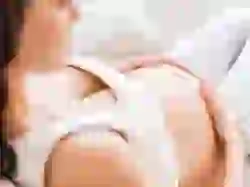
Pregnancy is the most exciting and touching state in a woman’s life. But along with the joys of new discoveries and the expectation of a miracle, specific problems arise. Specifically, skin changes such as stretch marks. You need to take care of yourself in advance so that after giving birth you still feel attractive. We will tell you what causes stretch marks and what you can do during pregnancy and after childbirth.
Stretch marks (striae) are internal scars of the skin, they arise due to stretching of the skin, the upper layer of skin (epithelium) does not keep up with the growth of the abdomen, elastin fibers are torn and replaced by scar tissue. It is difficult to predict the appearance and type of stretch marks.
The skin consists of three layers: the epidermis (the upper, constantly renewed layer), the dermis (a dense connective tissue frame, a kind of “mesh” that provides firmness and elasticity of the skin) - stretch marks appear in it, subcutaneous fatty tissue (adipose tissue, expressed in all to varying degrees).
Causes of stretch marks during pregnancy
1. Rapid growth of the abdomen.
Rapid growth of the abdomen may be a physiological change, or it may indicate excessive weight gain, polyhydramnios, or the formation of a large fetus. Your doctor will tell you how natural the changes in the body are; do not hesitate to ask about an exciting question.
2. Changes in hormonal levels.
During pregnancy, a woman's body must maintain high levels of progesterone, as this is the hormone that maintains pregnancy. Progesterone has a relaxing effect on smooth muscles, preventing the uterus from becoming toned. But along with the relaxation of the myometrium, the tone of all muscles decreases and the connective tissue of the dermis is weakened. The growing belly often outpaces the skin's ability to stretch, and tears form in the middle layer of the skin.
3. Poor nutrition before and during pregnancy.
An unbalanced diet is an insufficient intake of minerals, vitamins, protein and vegetable fats and an excess of carbohydrates and salt. In addition to the risk of gaining excess weight, a diet that often contains carbonated drinks, chips, processed foods, excess sugar, alcohol and fast food has a direct damaging effect on the skin. First of all, the synthesis of new collagen fibers in the dermis suffers.
4. Heredity.
Genetic predisposition can be traced very often; the point here is the inheritance of skin type (density, level of sebum production, ability to regenerate). It happens that a woman with a large belly during pregnancy, after the birth of a large baby or twins, has almost no skin changes. And the mother, who had a small belly throughout her pregnancy, is upset because of multiple bright stretch marks. Pay attention to similar changes in close relatives (mother, sister, aunt), ask. This will most likely help predict these changes.
5. Smoking.
In women who smoke, the synthesis of collagen and elastin is impaired, the skin is more “fragile” and the risk of stretch marks increases.
6. Age.
Primigravidas aged after 30 and under 18 years are at greater risk of getting unpleasant skin changes, since in the first case the synthesis of collagen is already somewhat slowed down, and in the first case the exchange of female hormones may not yet be stable.
7. Parity of births.
In multiparous women, changes in the skin of the abdomen are, of course, more pronounced. The break between births also matters. From many points of view, the optimal interval is a period of 2 years. During this time, the balance of hormones is restored, reserves of iron, calcium and other nutrients are replenished.
8. Concomitant diseases.
Obesity is a chronic metabolic disorder. The manifestation of the disease will be not only excess weight, but also impaired skin nutrition.
Also at greater risk are women who had stretch marks before pregnancy, childhood or adolescence (for example, due to hypothalamic syndrome).
Diabetes mellitus types 1 and 2 are also metabolic diseases. Due to increased blood sugar levels, collagen synthesis is disrupted, the skin becomes thinner, drier and much more easily damaged. The regenerative (restorative) abilities of the skin are also reduced.
Systemic diseases (systemic scleroderma, systemic lupus erythematosus and others), dermatitis, psoriasis cause specific changes in the skin, and also reduce its elasticity and regenerative abilities.
9. Motor mode.
A sedentary lifestyle reduces the delivery of oxygen to all tissues of the body. Physical inactivity also threatens excessive weight gain and fetal hypoxia.
10. Weakness of the muscles of the anterior abdominal wall.
Insufficiently trained muscles do not create a “muscle corset” and pressure on the skin from the inside increases.
11. Lactation.
We talk a lot about stretch marks on the skin of the abdomen and thighs and forget about the breasts, and meanwhile, active lactation can provoke such changes on the skin of the mammary glands. Especially in the first weeks after childbirth, when milk arrives, the skin of the breast experiences significant stress.
How do stretch marks appear in pregnant women?
Location of stretch marks according to frequency of occurrence: abdomen, breasts (breast enlargement during pregnancy and lactation is individual), hips and buttocks (physiological increase in fat layer is intended by nature for the normal exchange of female hormones, in particular estrogen, but weight gain is not always and not for everyone corresponds to the needs of the body), calves (stretch marks form here very rarely, mainly in women with severe swelling that cannot be treated for a long time).
Stretch marks can be pink, dark and light purple, or red in color and vary in width and length. From small narrow and light pink stripes in the lower abdomen or on the chest to wide dark purple stripes along the entire anterior abdominal wall and thighs. The critical period for the appearance of stretch marks on the abdomen and thighs is the third or fourth month of pregnancy, on the chest - the lactation period, on the legs - the postpartum period, when swelling decreases.
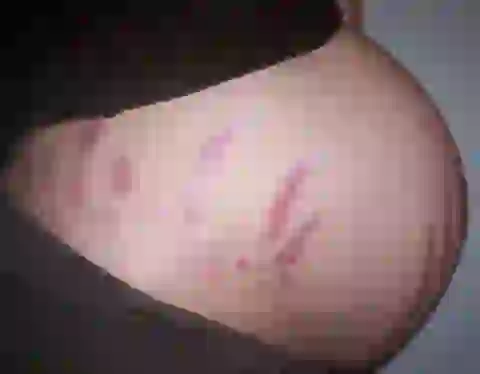
After childbirth, stretch marks gradually fade, become denser in texture and acquire a light silvery, white color. These changes do not completely disappear, but with proper care, skin tone is restored and stretch marks become less noticeable. Stretch marks do not tan because they are scar tissue and do not produce the pigment melanin.
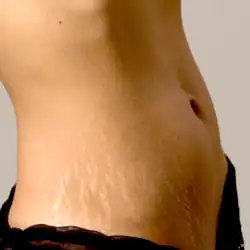
Prevention of stretch marks during pregnancy
Prevention of stretch marks should begin before pregnancy. Elastic, moisturized skin is much less susceptible to damage and has a greater ability to regenerate.
1. Normalization of weight.
You must control your weight independently and regularly; it is not recommended to gain more than 14 kilograms during pregnancy, and the risk of stretch marks increases with a sharp jump in weight.
2. Balanced nutrition.
In addition to weight control, a proper diet is designed to saturate the body with enough protein and vitamins. It is protein that helps the skin renew itself and maintains its elasticity.
It is recommended to include: vegetable oils, cottage cheese, chicken, turkey, eggs, cheese, beef, nuts, legumes. Also useful are foods rich in potassium (raisins, dried apricots, banana, pears) and an optimal drinking regime (still mineral water, natural fruit drinks, green tea up to 2 liters a day, if you have not been advised to limit fluids).
But flour, sweet and carbonated drinks should be excluded or significantly limited.
You should also take multivitamin complexes for pregnant women; they contain an optimal combination of vitamins and microelements and are easily absorbed.
3. Regular dosed physical activity.
Of all types of physical activity, walking and swimming are most suitable for pregnant women. There is also a special direction - fitness for pregnant women, it includes lightweight versions of physical training complexes, but, nevertheless, is effective for strengthening the muscular system. Find out from your doctor and, if there are no contraindications, start exercising. Classes can also be held at antenatal clinics.
If you want to practice at home, then use the following complexes, but first show them to your doctor. Classes are indicated after 12 weeks; in the first months the load should be minimized.
It is better to start classes accompanied by a spouse who can insure you.
Positional gymnastics for stretch marks
- cat pose: standing on all fours, smoothly round your back and lower your head down, and then arch your back and raise your head, repeat 10-12 times depending on how you feel
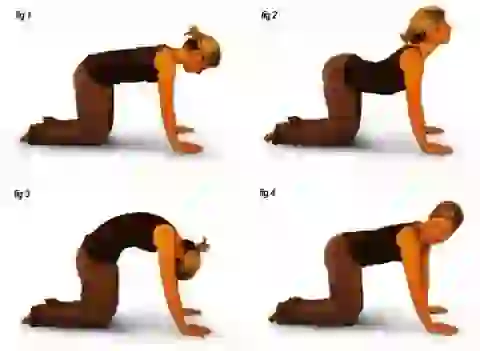
- butterfly pose: sit on the floor, bring your feet together with the soles of your feet and move them as close to you as possible, gently press on your knees with your palms and swing, as if making a “butterfly wings” movement

— twisting: while sitting or standing, rotate your torso left and right at a comfortable angle, while your pelvis remains motionless
Exercises with fitball (gymnastic ball)
- sit down in Turkish style and take the ball in your hands, raise it to the level of your face and begin to squeeze rhythmically with your palms, repeat 10-15 times (the muscles of the chest and arms are strengthened)
— we lie on our backs, legs are bent, the right one rests on the floor, and the left one stands on the ball, “roll” the ball with the left foot and return it to the starting position. For each leg, 6-10 repetitions.
- lie on your back, bent legs rest on the floor, then raise your left leg and rotate your foot to the right and left in turn, then repeat with the right leg
4. Wearing anatomical underwear for pregnant and lactating women, bandages.
Special underwear creates a soft but dense uniform compression, preventing the fabrics from sagging and stretching unnecessarily, does not cut into the skin and should be made of hypoallergenic, natural materials. You should start thinking about wearing such underwear from 12-14 weeks of pregnancy.

Wearing prenatal bandages is also recommended. The bandage should be purchased at an orthopedic pharmacy and the abdominal circumference should be measured first. The growth of the abdomen depends on many factors, and each woman may need a bandage at a different time, but on average, wearing it is indicated from 21 weeks.
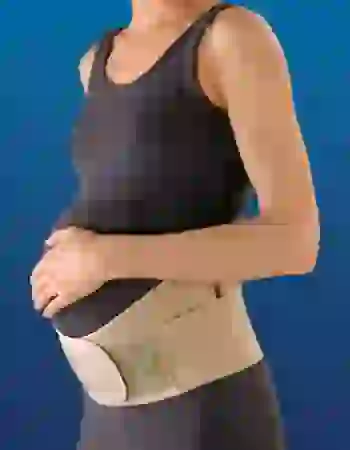
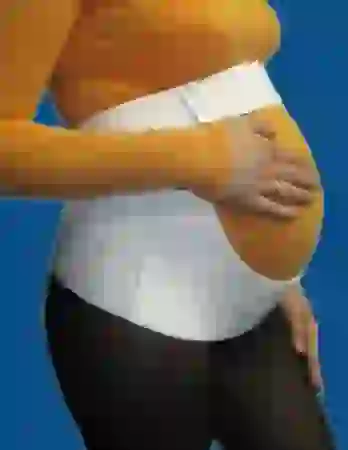
5. Massage.
Daily gentle massage prevents the appearance of stretch marks and has a general strengthening effect on the body. It consists of two stages:
- massage in the shower, the jet should make circular movements on the skin of the abdomen, chest and thighs, you should alternate cool (not cold!!) water with warm water, the period of exposure to warm water should be three times longer than cool water, a circular massage with a washcloth is also used -a mitten made of natural materials (loofah, sisal).
- massage using various creams and oils approved for pregnant women, performed on damp skin, using gentle circular movements.

The cosmetic products you use must be purchased at a pharmacy, labeled “hypoallergenic” or “allergen tested” and approved for use by pregnant and lactating women, and it would also be a good idea to require a hygiene certificate and a quality certificate.
You can use creams for stretch marks from the brands MamaComfort, Vichy, Avent, Sanosan, ChiccoMammaDonna, Clarins, Bioterm, Vitex FOR MOTHER, World of Childhood, GreenMama.
If you do not want to use industrial cosmetics, you can massage with heated olive, peach, almond oils or jojoba, cocoa, and grape seed oils.
If you are using oil, cream, gel or emulsion for the first time, then perform an allergy test, apply a small amount of the product to the elbow and observe for about 2 hours, if no redness, swelling, or itching appears, then you can safely use it.
Massage is contraindicated for women whose pregnancy is under threat of miscarriage, as it additionally stimulates the muscles.
6. Breathing exercises.
As a result of proper breathing exercises, the body is saturated with oxygen, which has a positive effect not only on the skin. You can alternate between gymnastic exercises and breathing exercises. Consult your doctor before starting this method.
Treatment of stretch marks after pregnancy
If faded stripes still prevent you from living and feeling attractive, then use the services of a cosmetologist. The most effective fight against stretch marks is up to 1 year of age, after which the fight becomes more difficult. Most methods can be used while breastfeeding, but still consult your gynecologist. The following methods are used:
1. Laser therapy.
Using a laser beam, the upper layers of the skin are polished and the color and structure are evened out; the procedure is performed under anesthesia.
2. Mesotherapy.
The essence of the procedure is that various drugs are injected into the skin around and in the stretch area. A very thin needle is used and solutions are injected to a depth of 3-5 mm. Most reviews are positive.
3. Microdermabrasion.
Grinding the skin using a special device, the effect will be noticeable quite quickly, but the trauma to the skin with this method is significant.
4. Microcurrent therapy.
Exposing the skin to currents of up to 1000 microamps increases blood flow and helps the skin renew itself. In addition to stretch marks, this method is used to treat acne and age spots that complicate pregnancy. Treatment, of course, after delivery.
5. Chemical peeling.
Applying a chemical composition (most often including fruit acids) to the skin, which causes the top layer to peel off and thereby even out the tone and structure. After the procedure, a superficial skin burn occurs and a recovery period is required. The method is not used in the sunny season, since irradiation causes persistent pigment spots to develop.
6. Ozone therapy.
Many injections with an oxygen-ozone mixture are made into the affected area. Metabolism improves and the production of new cells is stimulated.
7. Abdominoplasty.
The most radical method consists of removing damaged areas of skin and suturing the defect.
In addition to salon procedures, you continue self-massage and the use of specialized creams and oils.
Forecast
Stretch marks are a cosmetic nuance that does not threaten you and your baby in any way, so if you have already acquired such changes (like most women), then do not be upset or obsess over it. Over time, the stretch marks will fade significantly and will not be noticeable. Maintain a normal weight, apply our tips, because at any stage you can improve your skin condition.
And remember “the most beautiful of women is a woman with a child in her arms”!
Carrying a fetus causes many changes in a woman’s body. Most expectant mothers develop stretch marks on their stomach and chest during pregnancy and really want to get rid of them, because these scars look unattractive. Striae are a common, but completely solvable problem. Find out why they appear, what they look like, what treatment and prevention measures exist.
What are stretch marks during pregnancy?
In professional medical language, this phenomenon is called “striae.” Stretch marks are tears in the skin that appear as a result of loss of elasticity and firmness. Stretching due to the growth of the fetus, the integument becomes too thin. The inner layer of the epidermis is torn. Recovery occurs quickly, but noticeable scars remain, which are called stretch marks. You can get rid of them by taking timely measures.
What stretch marks look like
There are a lot of photos online showing scars. Striae appear on the abdomen, chest, sometimes thighs, and buttocks. At the initial stage, the stripes are colored pink, purple or lilac. This happens because there are many capillaries in the connective tissue. Then the scars lose color, become white, pearlescent, and will no longer be so noticeable in the photo. They always remain that way. Subcutaneous scars do not tan because there is no melanin pigment in the tissue.
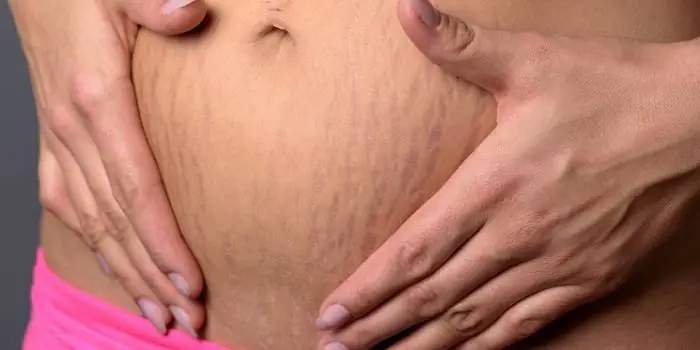
Why stretch marks appear during pregnancy
During this period, as the fetus grows, the uterus rapidly enlarges. The skin “does not have time to adapt” to these changes, becomes thinner, and connective tissue breaks appear from the inside. The main causes of stretch marks are progressive growth of the abdomen, uterine tone and weight gain. There are a number of factors that aggravate the situation:
- Hormonal changes. An increase in the level of progesterone and estrogen provokes the appearance of stretch marks. When the level of these hormones is high, less collagen, which is responsible for the density of the skin, and elastin, which ensures its easy stretching, are released.
- Heredity. Stretch marks on the abdomen during pregnancy often appear for this reason. With a genetic predisposition, stretch marks occur even if the pregnant woman has a small belly.
- Lifestyle. Scarring can be caused by poor nutrition, lack of vitamins, rapid weight gain, lack of physical activity, and smoking.
- Age. The older a pregnant woman is, the less elastic her skin is.
- Condition of the body. Scars more often appear in women with weak abdominal muscles or metabolic disorders caused by diabetes, obesity, and other diseases.
- Lactation. After childbirth, milk begins to flow into the breast, and it increases significantly in size. The skin stretches, which can result in stretch marks.
- Large baby, multiple pregnancy, polyhydramnios. In these situations, the belly grows very large, so the risk of scarring is higher.
When do stretch marks appear?
Intensive fetal growth begins approximately at the end of the first trimester of pregnancy. During this period, the first stretch marks become noticeable in most women. Each organism is individual. For some, scars form already in the first months or are absent altogether. Stretch marks on the breasts can appear during pregnancy, but more often they appear after childbirth. They are not as pronounced and less noticeable in the photo. This is due to milk actively arriving in the glands.
How to deal with stretch marks during pregnancy
There are a lot of ways to solve the problem. Depending on the severity and number of stretch marks, you can use one of them or several at once. Scars are eliminated with store-bought creams, lotions, vegetable and essential oils, folk remedies, massages, salon procedures, and special gymnastics. When choosing any method, it is advisable to follow these recommendations:
- drink at least two liters of water per day;
- engage in moderate physical activity;
- take vitamin and mineral complexes;
- wear supportive underwear, a special bra;
- regularly use selected cosmetic products for stretch marks;
- Healthy food.
What to smear on the stomach
Modern manufacturers produce a huge number of cosmetic products against stretch marks: creams, gels, oils. It is advisable to purchase them at a pharmacy. It is recommended to give preference only to those products that are marked “hypoallergenic”. Check whether cosmetics are allowed for pregnant and lactating women. It is advisable to familiarize yourself with the hygiene certificate and other documentation confirming the quality of the product.
There are a lot of cosmetic products for scars, among them there are both expensive and affordable products. When choosing a cream, pay attention to the composition. The product should include the following components:
- retinol (promotes cell regeneration);
- collagen (increases skin elasticity);
- hyaluronic acid (retains moisture inside cells);
- natural olive, shea butter, papaya, cocoa, grape seed, wheat germ oils (nourish, moisturize);
- vitamins (protect the skin from harmful effects).
It is advisable to buy the cream at a pharmacy or special stores selling goods for children. List of the best products for stretch marks:
- Avent. Has an anti-cellulite effect.
- Chicco, Donna Mama series. Provides soft and gentle care, moisturizes, increases elasticity.
- Mama Comfort. An affordable hypoallergenic cream that improves skin elasticity.
- 9 months. Contains natural active ingredients.
- Mustella. Prevents the appearance of new stretch marks and makes existing ones less noticeable.
- Pregnancy. Contains a natural complex.
- Sanosan. Prevents tissue rupture, nourishes, protects.
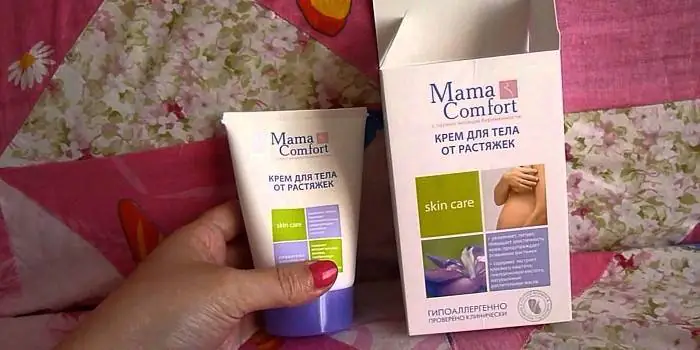
Oil
A very simple and affordable remedy for stretch marks. Olive oil, any cosmetic oil, essential oils will do. Many of them are very effective on the skin. For example, jojoba oil gives elasticity to the skin and helps remove stretch marks and other cosmetic defects. Peach has a rejuvenating and softening effect. Rosewood oil tightens the skin and resolves scars. You can mix several different types. Oils are applied to the skin with massage movements in a thin layer 1-2 times a day, having previously done a sensitivity test.
Masks
Products in this form of release contain an increased concentration of active components against scars. They will help get rid of existing stretch marks and prevent the occurrence of new ones. What masks can you buy:
- Royal Skin Smooth Control Patch. Removing stretch marks on the breasts during pregnancy. Restore elasticity, moisturize damaged skin, increase elasticity, enhance collagen production, fill stretch marks, smooth out scars and unevenness. Contains adenosine, which prevents aging. Patches are glued to problem areas for 3-4 hours.
- Zeytun, Body mask “Wrap” No. 7 for scars and stretch marks. Contains propolis, honey, Bailun clay, royal jelly, grape seed oil, yarrow, chamomile, lemon, frankincense, myrrh. The product is applied to cleansed skin for 25-30 minutes, then washed off with warm water. The procedure is repeated twice a week.
Positional gymnastics
There are a number of exercises that are very effective against stretch marks. They are completely safe for pregnant women. What poses will help fight scars:
- Cat. Get on all fours. Slowly round and arch your back while lowering your head down and up. Repeat 10-12 times. Monitor your health and stop exercising if it worsens.
- Butterfly. Sit on the floor. Bring your feet together with your soles and move them as close to you as possible. Using your palms, gently press on your knees and rock, imitating the flapping of a butterfly's wings.
- Twisting. While standing or sitting, rotate your torso left to right, leaving your pelvis motionless. Choose your own angle of twist at which you do not feel discomfort.
Exercises with fitball
A special gymnastic ball is a good helper for most pregnant women. It helps to reduce the load on your back and gently stretch. Exercises on a fitball against stretch marks:
- Sit cross-legged. Take a gymnastic ball in your hands. Raise it to face level and squeeze rhythmically with your palms. Repeat 10-15 times.
- Lie on your back. Bend your legs, place your right leg on the floor, and place your left on the ball. Roll the fitball and return to its original position. Do 5-10 repetitions on each leg.
- Rest your back and shoulder blades on the fitball. Bend your knees at an angle of 90 degrees. Place your hands behind your head. Gently lift your torso and hold for a few seconds to tighten your abdominal muscles. Repeat 5-10 times.
Salon products for removing stretch marks during pregnancy
If you are afraid that you will not be able to cope with stretch marks on your own, you can seek help from a professional cosmetologist. There are a number of salon procedures that are allowed to be performed during pregnancy. Seaweed wraps, thalassotherapy, and a bath with mineral salts are good for stretch marks. Before going for procedures, consult with your doctor to ensure there are no contraindications.
Folk remedies
There are several formulations that you can make yourself and use at home. This method has many advantages, the main one being naturalness. Home Remedies Recipes:
- Cream with mummy. Dissolves scars and scars. Buy mumiyo at the pharmacy. Mix 3-4 grams with 1 tsp. water and 80-100 g of baby cream (you can take anti-cellulite). Apply the product to stretch marks once a day. The use of this cream is prohibited during breastfeeding.
- Product with aloe and vitamin E. Mince the plant or finely chop it. Squeeze out half a glass of juice. Add the same amount of olive oil, 10 drops of vitamins E and A. Mix thoroughly. Apply the cream once a day to problem areas.
- Mix 3 tbsp. l. white clay, mashed pulp of one avocado, 1 tbsp. l. oat flour, 2 tsp. wheat germ or olive oil. Make the mixture homogeneous. Apply to problem areas for 10-15 minutes twice or thrice a week. Store the composition in the refrigerator.



